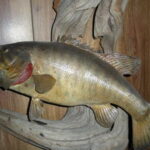If you’ve never done it fly-fishing for Smallmouth Bass is a must for all fly fishermen. Whether you enjoy stream, river, pond, or lake fishing, Smallmouth’s will provide you with all the challenges and rewards a fisherman seeks.
When I first learned to fly fish it was in pursuit of Smallmouth Bass. They inhabited many of the waters that were within a short driving distance to me at the time so if I only had a short time to fish it would be for Smallies. Getting prepared to fly fish for Smallmouths is a little different than trout fishing. First get yourself fitted with a moderately heavy rod. A 6-8 weight rod about 8-9 feet long is ideal. You can choose a lighter rod but using a heavier rod will make casting heavier, larger flies easier. Also you will not need to use light tippet as you would trout fishing. Normally I use 3x-sized tippet or I will just use a slightly longer piece of 8lb. leader.
Next you will need to get an assortment of flies. Many of the same flies will work whether you are fishing a river, lake, of pond. The flies I would recommend are streamers, large nymphs, poppers, larger dry flies and wooly buggers. Most of these flies I would gauge much larger than trout flies. I never use anything with a hook size smaller than 10 for Smallies and go as large as a 2/0 hook. My most consistent fly though has always been a brown wooly bugger in sizes 6-10. I truly believe there is no wrong way to fish this fly. You can add weight and drag it along the bottom like a crayfish, swing it or twitch it like a minnow, or even run it right under the surface. Most of the flies I recommend are sub-surface flies. Smallmouth don’t seem to key in on small bugs on the surface like trout do. However, there are times when dry fly fishing for Smallies can be outstanding.
Here in the Northeast many of the bigger mayflies hatch out from May to June, during this time fishing dry fly patterns to Smallies can be very successful. There have been many instances on the Schoharie Creek when I have pursued Smallies during March Brown hatches and done very well. Other than late spring most surface fishing for should be done with large patterns that can be worked across the surface. I like to use deer hair poppers in the summer months, but foam poppers and grasshopper imitations work just as well.
When fishing streams and rivers, larger Smallmouth seem to inhabit deeper pools and runs. Like I said dry fly fishing can be productive but fishing subsurface is normally the way to go. In the morning and evening I would recommend trying surface patterns just for the shear thrill of watching a Smallies explode on the surface, but subsurface is normally more productive. In Lakes and ponds, Smallies are anywhere from a foot to about 30 feet down but normally in water about 10-20 feet and for flies wooly buggers are hard to beat. I normally add a little weight and drag a brown wooly bugger on the bottom. I sure it somewhat resembles a crayfish, and even if it doesn’t Smallies love it. A few years ago my father and I were fishing for Smallies on a lake in the Adirondack Mountains of New York. I was fly fishing with my wooly bugger and he was fishing with live crayfish. I kind of felt bad because he is my dad, but while he only caught 2 I caught almost 10, and had many other spit the hook as they were flying through the air.
Smallmouth bass thrive in many of the waters in the Northeast. They are excellent fighters that are noted for their leaping ability and powerful runs. So do yourself a favor and give fly-fishing for Smallmouths a try, you won’t regret it.





